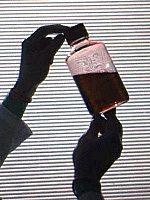|
 Color additives have long been a part of human culture. Archaeologists
date cosmetic colors as far back as 5000 B.C. Ancient Egyptian
writings tell of drug colorants, and historians say food colors
likely emerged around 1500 B.C.
Color additives have long been a part of human culture. Archaeologists
date cosmetic colors as far back as 5000 B.C. Ancient Egyptian
writings tell of drug colorants, and historians say food colors
likely emerged around 1500 B.C.
Through the years, color additives typically
came from substances found in nature, such as turmeric, paprika
and saffron. But as the 20th century approached, new kinds
of colors appeared that offered marketers wider coloring possibilities.
These colors, many whipped up in the chemist's lab, also created
a range of safety problems.
In the late 1800s, some manufacturers colored
products with potentially poisonous mineral- and metal-based
compounds. Toxic chemicals tinted certain candies and pickles,
while other color additives contained arsenic or similar poisons.
Historical records show that injuries, even deaths, resulted
from tainted colorants. Food producers also deceived customers
by employing color additives to mask poor product quality
or spoiled stock.
By the turn of the century, unmonitored color
additives had spread through the marketplace in all sorts
of popular foods, including ketchup, mustard, jellies, and
wine. Sellers at the time offered more than 80 artificial
coloring agents, some intended for dyeing textiles, not foods.
Many color additives had never been tested for toxicity or
other adverse effects.
As the 1900s began, the bulk of chemically
synthesized colors were derived from aniline, a petroleum
product that in pure form is toxic. Originally, these were
dubbed "coal-tar" colors because the starting materials
were obtained from bituminous coal. (These formulations still
are used today--albeit safely--for most certifiable color
additives.)
Though colors from plant, animal and mineral
sources--at one time the only coloring agents available--remained
in use early in this century, manufacturers had strong economic
incentives to phase them out. Chemically synthesized colors
simply were easier to produce, less expensive, and superior
in coloring properties. Only tiny amounts were needed. They
blended nicely and didn't impart unwanted flavors to foods.
But as their use grew, so did safety concerns.
In 1906, Congress passed the Pure Food and
Drugs Act. This marked the first of several laws allowing
the federal government to scrutinize and control additives
use. The act covered only food coloring. It was not until
passage of the Federal Food, Drug, and Cosmetic Act of 1938
that FDA's mandate included the full range of color designations
consumers still can read on product packages: "FD&C"
(permitted in food, drugs and cosmetic); "D&C"
(for use in drugs and cosmetics) and "Ext. D&C"
(colors for external-use drug and cosmetics).
Public hearings and regulations following
the 1938 law gave colors the numbers that separate their hues.
These letter and number combinations--FD&C Blue No. 1
or D&C Red No. 17, for example--make it easy to distinguish
colors used in food, drugs or cosmetics from dyes made for
textiles and other uses. Only FDA certified color additives
can carry these special designations.
The law also created a listing of color "lakes."
These water-insoluble forms of certain approved colors are
used in coated tablets, cookie fillings, candies, and other
products in which color bleeding could make a mess or otherwise
cause problems.
Though the 1938 law did much to bring color
use under strict control, nagging questions lingered about
tolerance levels for color additives. One incident in the
1950s, in which scores of children contracted diarrhea from
Halloween candy and popcorn colored with large amounts of
FD&C Orange No. 1, led FDA to retest food colors. As a
result, in 1960, the 1938 law was amended to broaden FDA's
scope and allow the agency to set limits on how much color
could be safely added to products.
FDA also instituted a pre-marketing approval
process, which requires color producers to ensure, before
marketing, that products are safe and properly labeled. Should
safety questions arise later, colors can be reexamined. The
1960 measures put color additives already on the market into
a "provisional" listing. This allowed continued
use of the colors pending FDA's conclusions on safety.
From the original 1960 catalog of about 200
provisionally listed colors, which included straight colors
and lakes, only lakes of some colors remain on the provisional
list. Industry withdrew or FDA banned many, while the rest
became permanently listed and are still used. Some of these
colors, derived from coal or petroleum sources, are subject
to certification and carry the F,D, or C prefix. Others, exempt
from certification, are pigments and colors derived from plant,
animal and mineral sources. They are found in a myriad of
products--from the caramel that tints cola drinks to the orange
annatto that gives color to cheese.
FDA certified over 11.5 million pounds
of color additives last fiscal year. Of all those colors straight
dye FD&C Red No. 40 is by far the most popular. Manufacturers
use this orange-red color in all sorts of gelatins, beverages,
dairy products and condiments. FDA certified more than 3 million
pounds of the dye in fiscal year 1992--almost a million pounds
more than the runner-up, FD&C Yellow No. 5.
|
